Benzene diazoniumtetrafluoro borate Δ−−→ Product (A) . In the above process product A is
Fluorobenzene
Benzene
1, 4- difluorobenzene
1, 3- difluorobenzene
The correct Answer is:1
To solve the question regarding the product (A) formed from the heating of benzene diazonium tetrafluoroborate, we can follow these steps:
1. Identify the Reactants: The reactant is benzene diazonium tetrafluoroborate. Its structure can be represented as:
- Benzene (C6H6) is a cyclic hydrocarbon with alternating double bonds.
- The diazonium part is represented as -N2^+ (a nitrogen-nitrogen triple bond with a positive charge).
- The tetrafluoroborate part is BF4^− (a boron atom bonded to four fluorine atoms).
2. Write the Structure: The complete structure can be illustrated as:
- C6H5-N2^+BF4^−
- This indicates that the diazonium group is attached to a benzene ring, and the tetrafluoroborate acts as a counterion.
3. Heating the Compound: Upon heating, the diazonium group (N2^+) is released as nitrogen gas (N2). This is a key step as the release of nitrogen gas drives the reaction forward.
4. Formation of Carbocation: The loss of the diazonium group results in the formation of a carbocation (C6H5^+). This carbocation is highly reactive and can undergo further reactions.
5. Nucleophilic Attack by Fluoride Ion: The tetrafluoroborate ion (BF4^−) can release a fluoride ion (F^−). This fluoride ion can then attack the carbocation formed in the previous step.
6. Formation of Product (A): The final product formed from the nucleophilic attack is fluorobenzene (C6H5F). The reaction can be summarized as:
- C6H5-N2^+BF4^− → C6H5F + N2 + BF3
7. Conclusion: Therefore, the product (A) formed from the heating of benzene diazonium tetrafluoroborate is fluorobenzene.
Final Answer:
The product (A) is fluorobenzene (C6H5F).
- Benzene (C6H6) is a cyclic hydrocarbon with alternating double bonds.
- The diazonium part is represented as -N2^+ (a nitrogen-nitrogen triple bond with a positive charge).
- The tetrafluoroborate part is BF4^− (a boron atom bonded to four fluorine atoms).
- C6H5-N2^+BF4^−
- This indicates that the diazonium group is attached to a benzene ring, and the tetrafluoroborate acts as a counterion.
- C6H5-N2^+BF4^− → C6H5F + N2 + BF3
The product (A) is fluorobenzene (C6H5F).
Similar Questions
Knowledge Check
- Question 1 - Select One
C6H6+CI2UVLight−−−−→ Product In above reaction product is .
ACCl3CHOBC6H6Cl6CC6H12Cl6DC6H9Cl2 - Question 2 - Select One
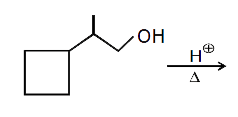
H⊕−−→Δ Major product
Major product isA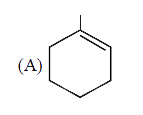 B
B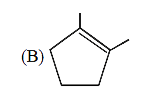 C
C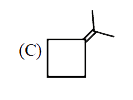 D
D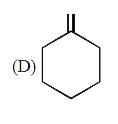
- Question 3 - Select One
Na(s)→air/Δ−−−→ product. Product will be
ANa2OBNa2O2CNaOHDAll of these
Benzene + Acetylchloride AlCl3−−→ product Name of the above reaction is
View SolutionC6H6+CI2UVLight−−−−→ Product In above reaction product is .
View SolutionSalicylic acid Δ−−→ product(s).
Product(s) will be :View SolutionCH3−CH3∣CH∣CH3−KMnO4−−−−→(A)H+−−→Δ(B)HBr−−−→ROOR(C)
Product (C) in the above reaction is:View SolutionBenzoic acid Δ−−−−−−−→NaOH+CaO Product will be
View Solution


 , Product End product of the above reaction is:
, Product End product of the above reaction is: